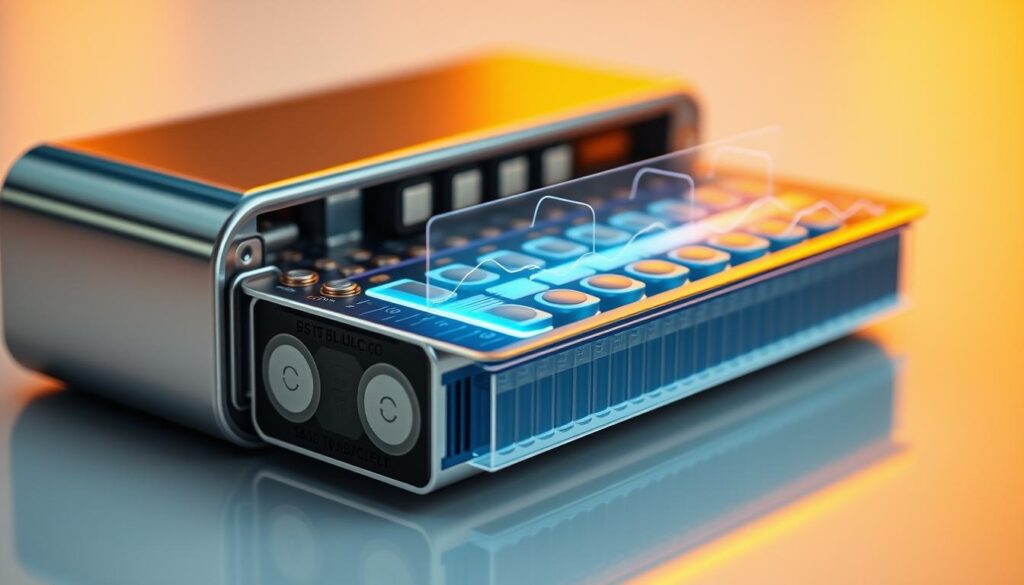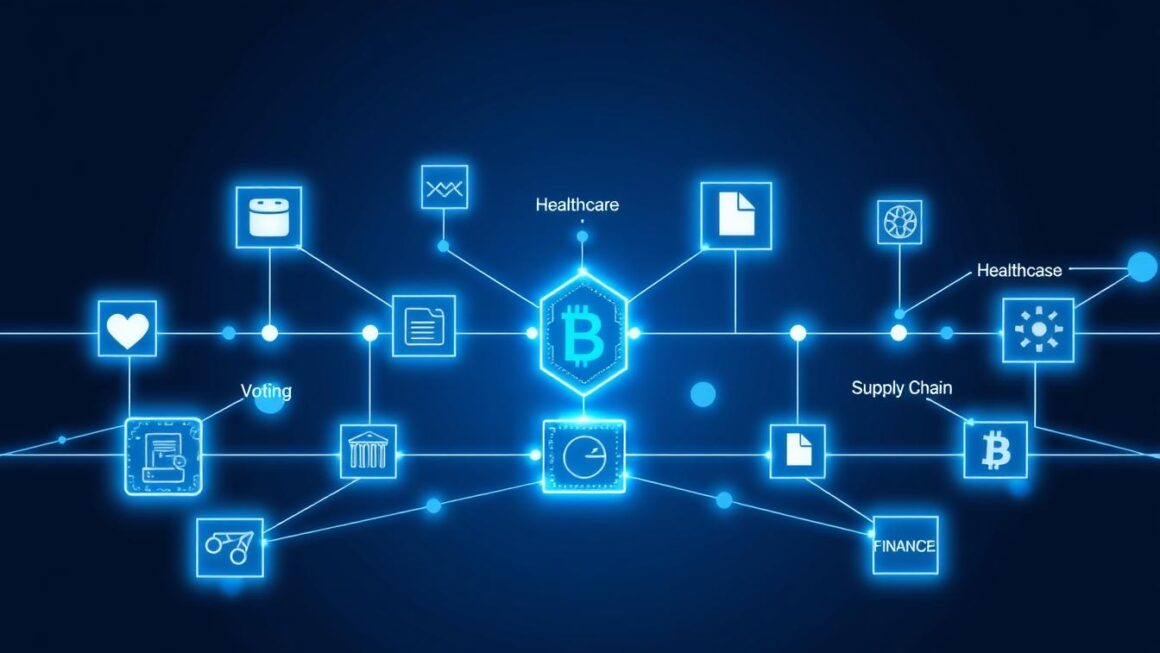The car world is on the verge of a big change. This is thanks to new future-proof battery technology. Stellantis and Factorial Energy have made a big step. They tested Factorial’s FEST solid-state battery cells, which are big enough for cars.
This achievement is going to change how we power our gadgets and cars. It will make them safer, more powerful, and better for the planet. As we move towards a greener, smarter energy future, solid-state batteries will play a huge role.
I think these new discoveries will be key in changing how we store energy. They will help more people use electric cars and cut down on fossil fuel use.
Key Takeaways
- Stellantis and Factorial Energy have validated Factorial’s FEST solid-state battery cells.
- Next-gen batteries offer improved safety, power, and eco-friendliness.
- The development marks a significant step towards future-proof battery technology.
- Solid-state batteries are poised to revolutionize the automotive industry.
- A cleaner, smarter energy future is on the horizon with these advancements.
The Evolution of Battery Technology
Battery technology has come a long way, from lead-acid to lithium-ion. This journey has been groundbreaking. It’s key to understand this evolution as we explore new energy storage methods.
From Lead-Acid to Lithium-Ion
Lead-acid batteries were the first, simple and cheap. But they were heavy and not very efficient. Then, lithium-ion batteries arrived, bringing better energy, longer life, and performance. Now, they power electric cars and gadgets.
Current Limitations of Traditional Batteries
Even with their progress, lithium-ion batteries have big challenges. They can catch fire, charge slowly, and harm the environment. As we want better and greener tech, these issues become clearer.
The Need for Innovation in Energy Storage
We urgently need high-performance batteries and advanced energy storage. New tech like solid-state batteries and fast charging is being worked on. Here’s a look at old and new battery tech:
| Technology | Energy Density | Charging Speed | Safety |
|---|---|---|---|
| Lithium-Ion | Moderate | Moderate | Good |
| Solid-State | High | Fast | Excellent |
Looking ahead, we’ll keep pushing for better advanced energy storage. This will help make electric cars and green energy more common.
Understanding Next-Gen Batteries: Solid-State, Fast-Charge, and Eco-Friendly Power
Next-generation batteries are changing the game with their solid-state design, fast charging, and green features. They’re set to shake up many fields, from electric cars to gadgets we use every day.
Defining Next-Generation Battery Technology
Next-gen batteries are a big step up from old lithium-ion batteries. They use solid-state technology, swapping the liquid part for a solid one. This makes them safer, more powerful, and quicker to charge. It’s a big deal for sustainable battery technology.
Key Technological Breakthroughs
Several major advancements are pushing next-gen batteries forward. These include better solid-state electrolytes, fast-charging tech, and eco-friendly materials. These changes boost battery performance and cut down on harm to the environment.
Market Growth and Investment Trends
The market for next-gen batteries is booming, thanks to more money going into cutting-edge power solutions. As we all want to be more green, the need for eco-friendly energy storage is growing. This trend is likely to keep going, with lots of money going into the field.
Big names in the industry are putting money into research and making more batteries. They’re working on making these new batteries affordable and easy to get.
Solid-State Battery Technology
Solid-state batteries are becoming more important for sustainable energy. They promise better performance, safety, and eco-friendliness in energy storage.
How Solid-State Batteries Work
These batteries use a solid material instead of liquid electrolyte. This makes them safer and more energy-dense. They also use lithium metal anodes, boosting energy storage.
Solid Electrolytes vs. Liquid Electrolytes
Solid electrolytes are safer than liquid ones, reducing fire risks. This makes solid-state batteries great for electric cars and gadgets.
Materials Science Innovations
New materials like ceramics and polymers are being used. They improve conductivity and stability, helping these batteries become more common.
Advantages of Solid-State Design
The design offers enhanced safety, higher energy density, and faster charging times. These benefits make solid-state batteries ideal for green energy and storage.
| Feature | Lithium-Ion Batteries | Solid-State Batteries |
|---|---|---|
| Electrolyte | Liquid | Solid |
| Safety | Risk of fire and explosion | Non-flammable |
| Energy Density | Moderate | Higher |
Current Challenges and Limitations
Despite their benefits, solid-state batteries face high costs and scalability issues. Overcoming these hurdles is key for their widespread use.
In conclusion, solid-state batteries are a big step towards green energy. As research improves, we’ll see more efficient, safe, and sustainable energy solutions.
Fast-Charging Battery Innovations

Fast-charging battery innovations are changing how we store energy. They make it quicker and more efficient to refill power. This is key in today’s fast world, where devices are always in use and need quick charges.
The Science Behind Rapid Charging
Rapid charging uses new battery types and smart charging methods. High-power charging lets batteries charge up to 80% in just 10 minutes. This cuts down on wait times for electric cars and gadgets.
Current Fast-Charging Technologies
Many fast-charging methods are being worked on. This includes high-power charging stations for cars and fast chargers for phones. These are made to work with new battery types that can handle fast charging without losing power.
Safety Considerations and Heat Management
Fast charging can make batteries hot. Advanced cooling systems and smart battery management are being created. They help keep batteries safe and cool during fast charging.
Future Developments in Charging Speed
Battery tech is getting better, leading to even faster charges. Scientists are looking into new battery types and designs. These could make charging even quicker while keeping it safe and efficient.
Eco-Friendly Battery Solutions
Next-generation batteries are more than just fast. They’re also better for our planet. As we aim for a greener future, how batteries are made and thrown away matters a lot.
Sustainable Materials in Battery Production
Using green materials in making batteries is a big step forward. Companies are looking for sustainable lithium sources and recycled metals. This change cuts down on the need for raw materials and lowers carbon emissions.
Reduced Environmental Impact
Eco-friendly batteries aim to harm the environment less. For example, solid-state batteries can make electric cars 39% greener if materials are sourced right. This big drop comes from better making and no toxic stuff.
Recyclability and End-of-Life Management
Being recyclable is key for green batteries. Next-gen batteries are made to be recycled, saving valuable stuff and cutting down on trash. Plans for how to handle old batteries are also getting better, making sure they’re disposed of right.
Carbon Footprint Comparison
| Battery Technology | Carbon Footprint |
|---|---|
| Traditional Lithium-Ion | High |
| Solid-State Batteries with Sustainable Materials | Up to 39% Lower |
In short, green battery tech is a big leap in sustainable battery technology. It’s all about using green stuff, being kind to the planet, making things recyclable, and looking at carbon footprints. This helps us see the good in new battery tech.
Applications in Electric Vehicles

Next-gen batteries could boost EV range by 50-80% and cut charging times. They are a big deal for cars. These advanced batteries could make driving electric vehicles much better.
Impact on EV Range and Performance
Solid-state batteries are changing electric cars. They replace liquid with solid, improving energy, charging speed, and safety. This means EVs can go farther on one charge, attracting more buyers.
Charging Infrastructure Requirements
Next-gen batteries will need more charging spots. Faster charging means more high-power stations are needed. This will push for better, faster charging tech.
Cost Implications for Manufacturers and Consumers
Next-gen batteries are good, but they’re pricey. At first, making them costs more. But, as production grows, prices will drop, making EVs more affordable.
Timeline for Mass Market Adoption
Next-gen batteries are getting better, and we’ll see more electric cars. Solid-state batteries will hit the market soon. By the end of the decade, they’ll be everywhere.
Next-Gen Batteries in Consumer Electronics
Next-gen batteries are changing the game for consumer electronics. They will make devices like smartphones, laptops, and smart home gadgets better. These new batteries will boost performance and extend battery life.
Smartphones and Wearable Devices
Smartphones and wearables will last longer on a single charge. Solid-state batteries could make devices more powerful and smaller. This means you can enjoy your gadgets for hours without needing to recharge.
Laptops and Portable Computing
Laptops and portable devices will get a big upgrade too. Faster charging and longer battery life mean you can work or play without interruptions. It’s all about making your experience smoother and more enjoyable.
Smart Home Devices
Smart home devices will also get a boost from next-gen batteries. Better battery life and efficiency mean more devices can go wireless. This makes your home automation experience even better.
User Experience Improvements
The user experience is about to get a lot better. With devices lasting longer and charging faster, you can use your gadgets without worry. Say goodbye to the hassle of constant recharging.
Grid-Scale Energy Storage Applications
Next-gen batteries are key to a greener energy future. They help store energy on a big scale. This is essential for using more renewable energy sources.
Supporting Renewable Energy Integration
Next-gen batteries can stabilize the grid by storing extra energy from renewables. This eco-friendly power storage makes it easier to use more renewables. It also cuts down on fossil fuel use.
Peak Demand Management
These batteries store energy when it’s not needed and release it when it is. This helps manage the grid better. It also lowers the chance of power outages.
Resilience and Emergency Power
Next-gen batteries can provide backup power during outages. This makes the grid more resilient. It’s very important for important places and areas hit by disasters.
Economic Viability Analysis
The cost of using next-gen batteries for energy storage is getting better. As technology improves and costs drop, it’s becoming more affordable. This makes it a good choice for utilities and grid operators.
In summary, next-gen batteries are a big step towards a greener, more reliable energy future.
Leading Companies and Research Institutions
Big names in tech and science are leading the way in new battery tech. They’re working on solid-state, fast-charge, and green batteries. This is a big challenge that needs lots of tech progress and money.
Major Corporate Players
Companies like Toyota and Samsung SDI are leading in solid-state battery tech. They’re spending a lot on research to make these new batteries available.
- Toyota is trying to make solid-state batteries hold more energy.
- Samsung SDI is working on making their batteries safer.
Innovative Startups
Startups like Factorial Energy are also making big strides. They bring fresh ideas and tech to the table, pushing innovation.
Academic and Government Research
Universities and government labs are key in improving battery tech. They do the basic research that leads to big discoveries in green battery innovation.
International Collaboration Efforts
Working together across borders is speeding up battery tech progress. Companies, labs, and governments are teaming up to tackle the tough issues of fast-charge and green batteries.
This teamwork is expected to lead to big leaps in battery tech. It will help make these new batteries common in our daily lives.
Practical Considerations for Early Adopters
Getting into next-gen batteries means understanding their real-world uses. High-performance and sustainable batteries have a lot to offer. But, there are important factors to think about before jumping in.
Current Availability and Pricing
Next-gen batteries like solid-state and fast-charging ones are slowly hitting the market. But, they’re pricey. This makes them more expensive than older battery types.
Performance Expectations
Next-gen batteries promise better performance. They last longer and charge faster. For example, solid-state batteries can hold up to 50% more energy than lithium-ion ones.
Compatibility with Existing Systems
It’s also key to think about how these new batteries fit with what we already have. Many new gadgets are made for these advanced batteries. But, older devices might not be compatible.
Investment Value and Long-Term Savings
Even though next-gen batteries cost more upfront, they can save money in the long run. They charge faster and last longer. This can lead to big savings over time. Here’s a table showing the possible savings:
| Battery Type | Initial Cost | Average Lifespan | Long-Term Savings |
|---|---|---|---|
| Traditional Lithium-Ion | $100 | 5 years | $0 |
| Solid-State Battery | $150 | 8 years | $200 |
| Fast-Charging Battery | $120 | 6 years | $100 |
In summary, next-gen batteries have their challenges for early adopters. Yet, their benefits in performance and savings are worth considering. They’re a good choice for those ready to invest in better battery tech.
Conclusion: The Future of Energy Storage
Next-gen batteries, like solid-state batteries, are changing how we store energy. They promise faster charging, better safety, and less harm to the environment. These advancements are key for a green energy future.
Innovation and investment in these batteries are essential. They will help us achieve a cleaner, smarter energy world. We’ll see big improvements in electric cars, gadgets, and large energy storage systems.
The future of energy storage is bright, with next-gen batteries leading the way. Their advanced features and eco-friendly design will be critical in shaping our energy future.



